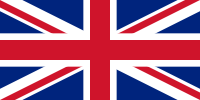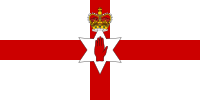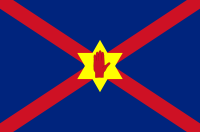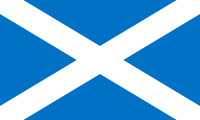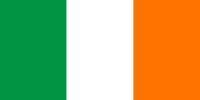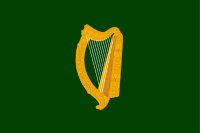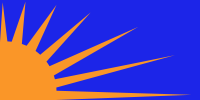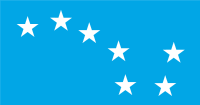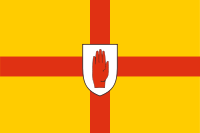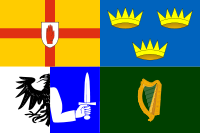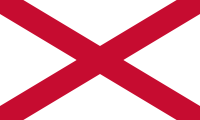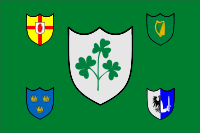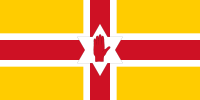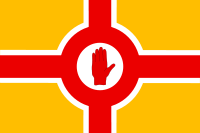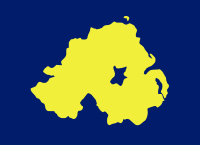- Northern Ireland flags issue
-
The Northern Ireland flags issue is one that divides the population along sectarian lines. Depending on political allegiance, people identify with differing flags and symbols, some of which have, or have had, official status in Northern Ireland.
There have been various proposals as to what flag could represent Northern Ireland's various communities as a whole; see below for some suggestions.
Contents
Unionist/loyalist flags
Union Flag
The flag of the United Kingdom, the Union Flag or Union Jack, is the only official flag, and is routinely used on central government buildings in Northern Ireland.[1] It is made from an amalgamation of the crosses of St George (representing England), St Andrew (representing Scotland) and St Patrick (representing Ireland).
The Union Flag is often flown by Unionists and Loyalists but is disliked by Nationalists and Republicans.
Ulster Banner
The Ulster Banner, the former Executive Committee of the Privy Council of Northern Ireland flag, was used from 1953 to 1972 by the Stormont government to represent the government of Northern Ireland.[2] When the government of Northern Ireland was suspended in March 1972 and dissolved under the Northern Ireland Constitution Act 1973, its arms and flag officially disappeared; however, the flag continues to be used by some local governments, such as the predominantly unionist Castlereagh, which continues to fly it outside its offices,[3] and by some NGOs representing the territory. It continues to be used by some sports teams representing Northern Ireland internationally, for example by the Northern Ireland football team,[4] and by the Northern Ireland Commonwealth Games team.[5] The Banner dates from 1953, though the design (which appears in the Northern Ireland coat of arms that dates from 1924) is based on the flag of the Irish province of Ulster which covers what is now Northern Ireland and three counties of the Republic of Ireland. There are four differences with the Flag of Ulster, namely the white background, the six-pointed star (representing the six Northern Ireland counties), the open thumb[citation needed], and the inclusion of the crown.
UK Government law and policy states that in Northern Ireland: The Ulster flag and the Cross of St. Patrick have no official status and under the Flags Regulations are not permitted to be flown from Government Buildings.[6]
Ulster Nation flag
This flag is used by Ulster separatists who wish to see Northern Ireland leave the United Kingdom and become an independent state, not joining together with the Republic of Ireland.
The flag is made up of St Andrew's cross (below), St Patrick's Cross (above) and the Red Hand of Ulster and star from the Northern Ireland flag (above), with the star coloured yellow (instead of white as in the Ulster Banner) based on the colours of the flag of the Irish province of Ulster.
St Andrew's Saltire
St Andrew's Cross is the flag of Scotland, and is one of the flags which makes up the Union Flag. It is used by some Loyalists in Northern Ireland to highlight their Scottish ancestry. St Andrew was one of the disciples of Jesus Christ and the flag is said to have been inspired by a white cross of cloud appearing on a blue sky to a Scottish King preparing for battle.
Nationalist/Republican flags
Irish Tricolour
The "Flag of Ireland" or "Irish Tricolour" is the national flag of the Republic of Ireland.[7] It is often flown by Republicans and Nationalists to show their support for a united Ireland. Article 7 of the Constitution of Ireland states: "The national flag is the tricolour of green, white and orange." A common interpretation is that the green represents Gaelic culture and Irish nationalism, the orange represents the Orange Institution, and the white representing peace between them.[8] It was first flown publicly by Thomas Francis Meagher, leader of the "Young Irelanders", at a meeting in Waterford on 7 March 1848.
The Flags and Emblems Act, 1954, which had been enacted by the Unionist Government at Stormont, restricted the display of flags and emblems which would cause a breach of the peace, which in practical terms affected the Tricolour most often. This act was repealed in 1987 by the UK Government at Westminster.
The flying of the Irish Tricolour by Nationalists in Northern Ireland on St Patrick's Day has caused some controversy, with Unionists arguing that St Patrick is the patron saint of the whole of Ireland, not just the Republic of Ireland or its citizens. Nationalists, however, argue that the flag represents all of Ireland, point to its intended meaning of peace (white) between both nationalist (green) and unionist (orange), and argue that there is no official flag at present for the whole of Ireland. Nationalists believe that there should not be a problem with flying the Tricolour on this day as Unionists fly the former flag of the Northern Ireland Government (The Ulster Banner) during the 12 July celebrations. The Twelfth, however, is an overtly unionist event, whereas St Patrick's Day is intended to be non-political.
Some local councils have debated the usage of the flag. Belfast City Council for example, had this flag in the Lord Mayor's official office, when put in place by former Sinn Féin Lord Mayor Alex Maskey, MLA, along with the Union Flag. When the Social Democratic and Labour Party's (SDLP) Alban Maginness was previously Lord Mayor, however, he had neither flag in his office.
Use of the flag in Northern Ireland has been debated in recent years, with Belfast City Council discussing (in September 2003), amongst other things, using the flag to fly alongside the Union Flag on designated occasions. The debate, however, all but collapsed after the long term suspension of the Northern Ireland government.
Green harp flag
Further information: Green EnsignUse of the harp as an Irish heraldic device can be traced to the 16th century. A gold harp on a green flag was used by Eoghan Rua Ó Néill (Owen Roe O'Neill) in 1642, when he commanded Irish Confederate soldiers during the so-called "Irish Confederate Wars", but was recognized as the colour of Ireland only with the Rebellion in 1798. The harp pillar by the 17th century was shaped into a grotesque head of a mythological beast. During the 2nd half of the 17th century, it was further transformed into a female head and torso. In the 18th and 19th centuries, the figure acquired a pair of wings, one of which formed the neck of the harp. The figure became known as the "Maid of Erin", and became incorporated into the British arms representing Ireland.[9]
Throughout the 1800s, the green harp flag was the main flag used by Irish nationalists. After 1916, the Irish Tricolour became the main nationalist/republican flag, after it was hoisted during the Easter Rising.
Sunburst flag
The "Sunburst flag" was first used in 1858, by the Fenian Brotherhood and Irish Republican Brotherhood (IRB). It is meant to symbolize the Fianna warriors of Irish mythology, who are given the epithet of Gal Gréine or Scal Ghréine, meaning "sunburst".
Versions of the flag were adopted in 1893 by Conradh na Gaeilge (an Irish-language group), and in 1909 by Fianna Éireann (a republican youth movement). Since then it has been used mainly by the youth wings of republican groups such as Na Fianna Éireann.
It should be noted that there is more than one version of the flag. The earliest versions have a green background with a golden "sunset" in the middle. On modern versions, the sun may be orange, gold or yellow and may be closer to the middle.[10]
Starry Plough flag
An early version of the Starry Plough banner was first used by the Irish Citizen Army, a socialist republican paramilitary group. The ICA was formed in 1913 and took part in the Dublin Lockout (1913) and the Easter Rising (1916). The blue and white version was designed by members of the Republican Congress in the mid-1930s. It was subsequently used by Sinn Féin, Official Sinn Féin and the associated paramiltary groups, and was also adopted by groups within the "Irish Republican Socialist Movement" and socialist republicans in general. Groups that currently use it include the Workers' Party, Irish Republican Socialist Party (IRSP) and Irish National Liberation Army (INLA).
The flag depicts the constellation of Ursa Major —known as The Plough in Ireland and Britain— which is one of the most noticeable features of the night sky over Ireland throughout the year.
Ulster flag
The flag of the Ulster—the nine-county province that incorporates three counties from the Republic of Ireland and the six counties of Northern Ireland—flown in Gaelic Athletic Association matches both between provincial and county-based teams. It is also often used by supporters of the Ulster rugby team[11] and notably appears on the coat of arms of the Ulster Unionist Party. At the 2011 Rugby World Cup, the Ireland team have entered the field of play at the beginning of their matches with the Irish tricolour and the Ulster flag.[12]
Four Provinces flag
A "four provinces flag" incorporates the flags of the four Irish provinces of Ulster, Munster, Leinster and Connacht, and is sometimes used to represent the entire island of Ireland. It is used by nationalists and by some all-Ireland institutions such as the Irish Rugby Football Union and is intended to be a more neutral flag than the Irish tricolour.
Flags often seen as neutral
Saint Patrick's Saltire
The Cross of St Patrick is a red saltire (X-shaped cross) on a white field. Many theories exist concerning its origin, but it was not widely used before the 19th century.[13] It was chosen to represent The Most Illustrious Order of Saint Patrick in 1783 and used to represent Ireland on the Union Flag arising from the union of the Kingdom of Great Britain and the Kingdom of Ireland in 1801.
It is used in some St. Patrick's Day parades in Northern Ireland, notably in parades organised by Down District Council and Belfast City Council, and flown at some council offices (notably Belfast City Hall).[14] In the case of the City Hall, this happened first in 1994, after the council's Policy and Resource committee had passed a resolution approving its use in January of that year. It is also used on the emblem of the Police Service of Northern Ireland.[15]
Sporting flags
In several sports, the Republic of Ireland and Northern Ireland are represented by one team. Because of this, the flags designed for and used by the teams are often seen as neutral, as they are made to represent both countries as one. The flag of the Ireland cricket team, featuring a shamrock, was made to represent the island of Ireland in its entirety. Although it has no official usage outside cricket, it is a neutral flag of Ireland.[16] The same can also be said for the flag of the Ireland national rugby union team.
Possible replacements
As there is currently no unique official flag for Northern Ireland, there have been various suggestions about what should be done. Apart from reusing an existing flag (such as the Cross of St Patrick), various new designs have been created.
This flag was being considered by the UK Government in the late 1990s and was leaked to BBC News.[17] It was never officially proposed. It is essentially the old NI Government Flag with the crown removed and some yellow taken from the Province of Ulster Flag.
When this flag was shown by journalists to various people around Belfast, the reaction was mainly unfavourable. Although some liked its inclusive nature, many responses were along the lines of "We already have a flag, it's the Union Jack" or "We already have a flag, it's the Tricolour".[citation needed]
This was a later design from the Flag Institute in 1998 shortly after the Good Friday Agreement, and again reaction was muted. The design attempted to hark back to the ancient flags of Ulster and the origins of the two communities. It retains the gold and red cross arms of the de Burgh Earls of Ulster and ancient symbol of the Red Hand of Neil, albeit with open thumb. The six pointed star was dropped for being "too loyalist" for the republican community. The white fimbriation (or edge) to the cross was included for two reasons, one to reflect the Norse heritage of Ulster and secondly to echo the Union flag. This was to balance the use of a gold background on the Provincial Ulster Flag and the white background of the Ulster Banner.
In 2003, the Alliance Party of Northern Ireland, which claims to represent both Nationalists and Unionists, came up with a few suggestions. One showed a flax flower, another a few steps from the Giant's Causeway and another (pictured, to right), a map of Northern Ireland (compare with the Korean Unification Flag or with the Flag of Kosovo).
See also
- Flag of Northern Ireland
- List of flags of the United Kingdom
- List of flags used in Northern Ireland
- List of flags of the Republic of Ireland
References
- ^ "The Flags Regulations (Northern Ireland) 2000" (PDF). Northern Ireland Assembly. http://www.niassembly.gov.uk/adhocs/flags/flags.pdf. Retrieved 5 October 2011.
- ^ Encyclopaedia Britannica says: According to British tradition, a coat of arms or flag is granted to the government of a territory, not to the people residing there
- ^ Castlereagh (1970-01-01). "Castlereagh Borough Council, Northern Ireland". Maps.google.com. http://maps.google.com/maps?f=q&source=s_q&hl=en&geocode=&q=BT8+6RB&sll=54.573057,-5.883522&sspn=0.092342,0.33577&ie=UTF8&hq=&hnear=Belfast,+County+Antrim+BT8+6RB,+United+Kingdom&ll=54.565041,-5.908547&spn=0.000728,0.003645&z=19&layer=c&cbll=54.565011,-5.90838&panoid=scerOoEYaPbz-HoxX-xQtA&cbp=12,29.55,,0,0.6. Retrieved 2011-09-26.
- ^ "Northern Ireland". FIFA. http://www.fifa.com/associations/association=nir/index.html. Retrieved 5 October 2011.
- ^ http://www.commonwealthgames.com/ Commonwealth Games website. Choose "Northern Ireland" from the "Countries" menu.
- ^ "The Union Flag and Flags of the United Kingdom" (PDF). Parliament of the United Kingdom. http://www.parliament.uk/documents/commons/lib/research/briefings/snpc-04474.pdf. Retrieved 5 October 2011.
- ^ The name of the state is officially "Ireland", in this case Republic of Ireland is being used for disambiguation purposes. (See Names of the Irish state).
- ^ http://www.taoiseach.gov.ie/attached_files/Pdf%20files/The%20National%20Flag.pdf
- ^ Andries Burgers Ireland: Green Flag, Flags of the World (21 May 2006), citing G. A. Hayes-McCoy, A History of Irish Flags from earliest times (1979).
- ^ "Detailed information of the flags history @". Crwflags.com. http://www.crwflags.com/fotw/flags/ie-sun.html. Retrieved 2011-09-26.
- ^ "Celtic League crowds soar to the half million mark". Ulster Rugby. 5 October 2011. http://www.ulsterrugby.com/news/1780.php.
- ^ "The Anthems at the Ireland v Italy Rugby World Cup 2011". youtube.com. 5 October 2011. http://www.youtube.com/watch?v=decrl8EMQUw.
- ^ "St Patrick's Flag". Doyle.com.au. http://www.doyle.com.au/st_pats_flag.htm. Retrieved 2011-09-26.
- ^ "Paddy's Day Belfast Bash" from Everything Ulster, 17 March 2006
- ^ "Cross Of St Patrick". Ulsternation.org.uk. http://www.ulsternation.org.uk/cross_of_st_patrick.htm. Retrieved 2011-09-26.
- ^ The Official website of Cricket Ireland use said flag to represent the Ireland cricket team's results, and since the Ireland Cricket Team represents both Ireland and Northern Ireland, the flag can be seen as neutral.
- ^ BBC Inside Ulster Report circa 1995
External links
- Symbols in Northern Ireland - Flags Used in the Region by Dara Mulhern and Martin Melaugh; illustrated article from CAIN Project (Conflict Archive on the INternet)
Categories:- Flags of Northern Ireland
- Flag controversies
Wikimedia Foundation. 2010.

